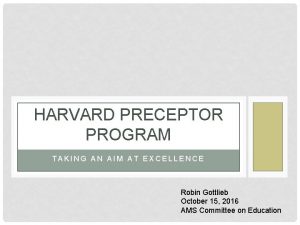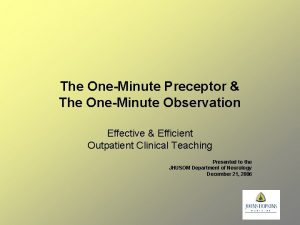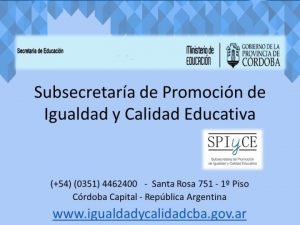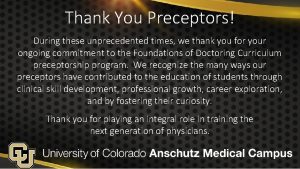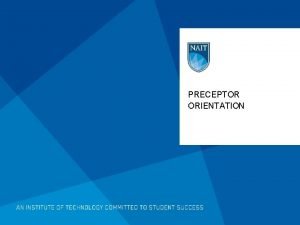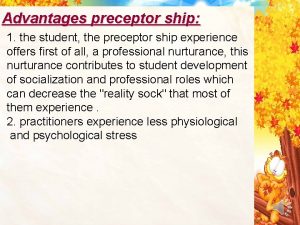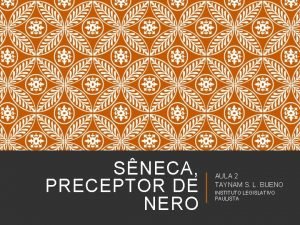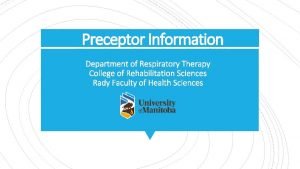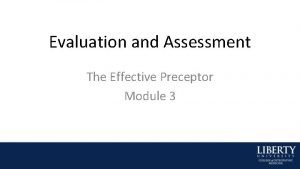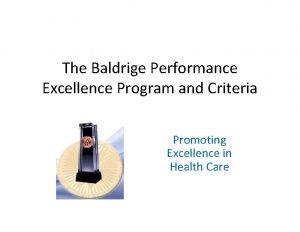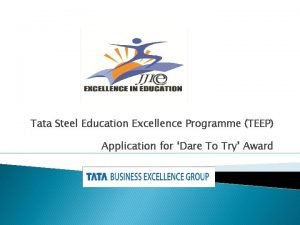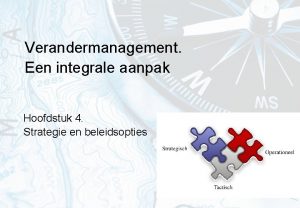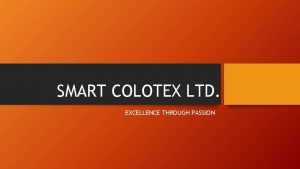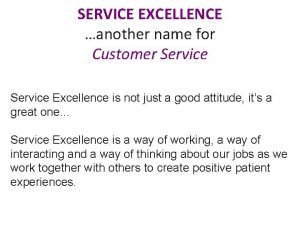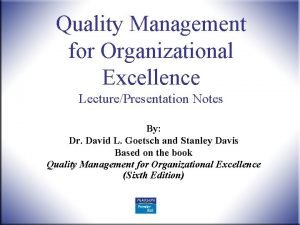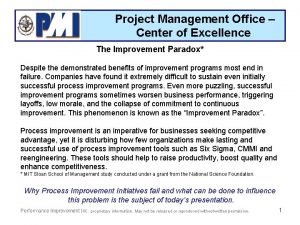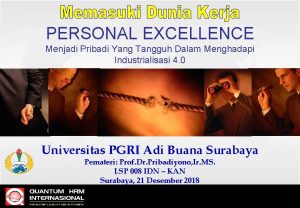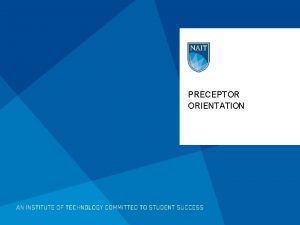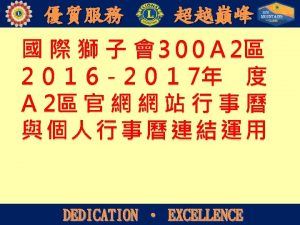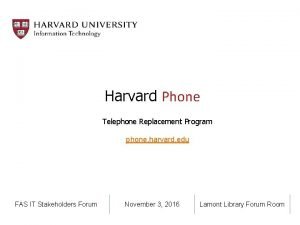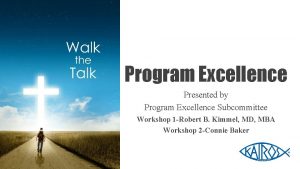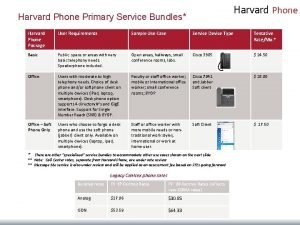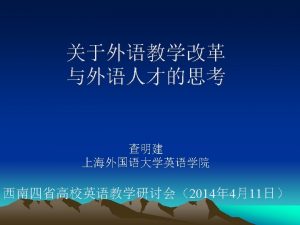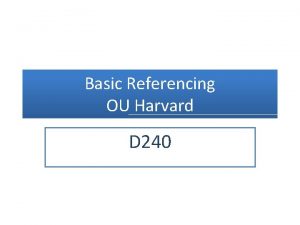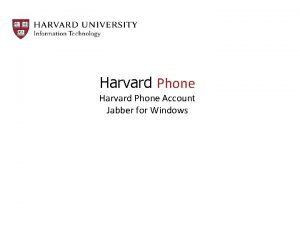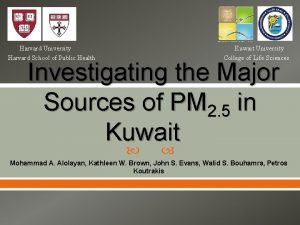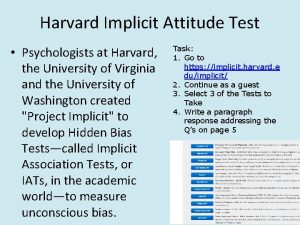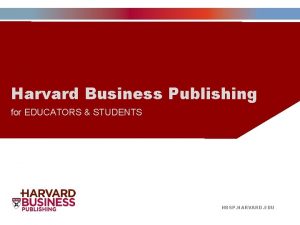HARVARD PRECEPTOR PROGRAM TAKING AN AIM AT EXCELLENCE





























- Slides: 29

HARVARD PRECEPTOR PROGRAM TAKING AN AIM AT EXCELLENCE Robin Gottlieb October 15, 2016 AMS Committee on Education

TODAY’S CHALLENGES • Serving increasing numbers of undergraduate students, many of whom are not well-prepared • Weak mathematical skills • Ineffective learning strategies • Transforming a mathematical mindset that doesn’t always involve sense-making • Supporting graduate students to successfully teach a diverse undergraduate community

TASKS RESOURCES? • Serving • Transforming • Supporting Time intensive; Pedagogical and content knowledge required

TOP QUALITY CALCULUS EDUCATION? • Are we offering top quality calculus courses? • What does that mean, “top quality”?

Insights and Recommendations from the MAA National Study of College Calculus (2015) Edited by Bressoud, Mesa, and Rasmussen. Summarizes results from the NSFsponsored project, Characteristics of Successful Programs in College Calculus. (available for free download on the MAA site. )

8 FEATURES OF SUCCESSFUL CALCULUS PROGRAMS (SLIDE COPIED FROM BRESSOUD WITH ORDER CHANGED) 1. Coordination of courses 2. Regular meetings of course instructors 3. Support for active learning 4. Solid GTA professional development 5. Strong student support services 6. Attention to placement issues 7. Attention to local data 8. Rigorous courses

HOW CAN A RESEARCH DEPARTMENT ADOPT THESE FEATURES? • Questions: • Can top-tier researchers do all this and have time for research? • To what extent is the best use of our researchers’ time? • Can graduate students learn to do this well? • If so, who will support them in learning to do this? • Can we count on post-docs to “take care of calculus”? Would they necessarily have the skills? Would they have the incentive? The investment?

OUR ANSWER TO THESE QUESTIONS EVOLVED OVER TIME • 1982: David Mumford’s chairmanship • The birth of the apprenticeship program • Response to pressure from students, parents, and deans • mid 80’s – early 90’s: ad-hoc, ‘creative’ staffing • Grads from other STEM fields, visitors, local unemployed mathematicians wandering Harvard Square • Where is the investment? How does this move us forward? • Adjuncts? no; A few ad-hoc preceptors OK • mid 90’s: David Kazhdan’s chairmanship • David asked for a 5 -year plan; my plan involved advertising preceptor positions

EVOLUTION OF PRECEPTOR PROGRAM • Late 1990’s: next chairman’s plan ~ no more preceptors • No preceptors faculty time commitment was too high • Change of plan: put out ad and hire preceptors • By 2000 the preceptor program was established

KEY ELEMENTS • Advertised positions • Shared vision of excellence • Creating “niches” or administrative specialties that matched the candidates skill set and trajectory goals • Desired traits include • • • Strong teaching Strong mentorship skills Good team player Some versatility Good judgment Respect for all members of the academic community

PRECEPTOR IMPACT: • Return to the 8 features of a successful calculus program

8 FEATURES OF SUCCESSFUL CALCULUS PROGRAMS (SLIDE COPIED FROM BRESSOUD WITH ORDER CHANGED) 1. Coordination of courses 2. Regular meetings of course instructors 3. Support for active learning 4. Solid GTA professional development 5. Strong student support services 6. Attention to placement issues 7. Attention to local data 8. Rigorous courses

CALCULUS TEACHING • Students are taught in classes of 22 -35 students. • A course head (sr faculty or a preceptor) coordinates each course. • Teaching teams include • • senior faculty preceptors graduate students jr. faculty/post docs

Interconnected Communities Research Faculty Preceptors Undergraduates Graduate Students

PRECEPTOR IMPACT • Coordination of courses ~ with common syllabus • Sr. Faculty member coordinates with help of preceptor or • Preceptor coordinates • Constructing thoughtful, interesting, appropriate problem sets • Website management • Course assistant supervision • Exam problem collection and construction • Grading coordination • Coordinates calculus coaching for students in trouble

PRECEPTOR IMPACT • Regular meetings of course instructors • Run weekly course meetings (or help run them) • Pedagogical Support : lead discussions on common difficulties and misconceptions • Institutional memory ~ what worked, what didn’t • Repository of good active learning ideas • Share/ post lesson plans, good in-class problems, worksheets • share demos or demo ideas • TA observation and support ~ support in real time, too. • Support active learning

PRECEPTOR IMPACT • Solid GTA professional development • Pedagogy course for all 1 st year grads • Apprenticeship Program • Graduate Calculus Coach Program • Annual Calculus Teaching Orientation • First class previewings for all first-time teachers • Class observations • Midterm questionnaire reviews

PREPARING GRADUATE STUDENTS TO TEACH • Conduct (mandatory) pedagogy course for first year grad students • • Iterated videotaped microteaching and class visits Individual video consultations with each student Teaching through questions: ask; don’t tell. Multiple class observations ~ impacts the culture • Teaching Apprenticeship Program • 1 -2 weeks of visits plus 1 week of teaching (including videotaped 2 nd hr + consult)for each grad student • Calculus Coach Program

PROGRAM IMPACT • With the support of the senior faculty the program and help of key graduate students, the program has successfully changed the culture of the graduate students around teaching. This, in turn, has broader positive impact when our graduate students become faculty members themselves. In 9 years, three graduate Levenson Award winners – all non-native speakers, all previously calculus coaches.

PRECEPTOR IMPACT • Strong student support services • Teacher Support – individually tailored • CA facilitated sessions: • - Problem sessions - math workshops • - Mini-quizzes - group quizzes • Graduate Calculus Coaches • Coaches work with tiny groups of struggling students • Math Question Center

PRECEPTOR IMPACT • Attention to placement issues • Available for 1 on 1 advice for the myriad of “special cases” • Look at the efficacy of our placement exam (from local data) • Work alongside sr. faculty on improving the section that is the least useful placement indicator

RESEARCH FACULTY - PRECEPTOR COLLABORATION • Rigorous Courses ~ with an emphasis on concepts • Synergy: Examples from 2 nd semester calculus - Shlomo Sternberg: epidemiology curriculum - Cliff Taubes : more focus on approximation and bounding - Jr. Faculty (Lior Silberman): asymptotics - preceptor series concept-test curricular adjustment

Introductory Calculus Courses Preceptor s Researc h Faculty Calculus Students Undergrad CAs Calculus coaches Grad students postdocs

TEAM REFLECTION ON COURSES • Post-course “debriefing” as a community • Strengthens courses • Models reflection as a part of pedagogical practice • Synchrony between constant incremental improvements and institutional memory

Other Projects • Calculus Practitioner Series • Emerging Scholars Program • Math Book Group (for beginning students) • Second chances in lowest level course – “revisiting” problems -> growth mindset • STEM dinners for interested beginning calculus students

Mission Stretch • Assistant to the Director of Undergraduate Studies – arranges social events, community-building – keeps ears to the ground – shamelessly encouraged to publish monthly newsletters along the lines of Stephen De. Backer’s Math Missives at U. of Michigan • Help with hiring and training undergrad CAs for upper level courses (in consultation with sr. faculty) • Math Table (along with sr. faculty) • Occasional undergraduate research projects

IMPLEMENTATION CHALLENGES • Buy-In: • To work, key faculty buy-in is critical. • Preceptors should be members of the department, not a separate department. This was important to sr. faculty: not two different depts. • Hiring Challenges • Preceptors and sr. faculty should be involved in the hiring process of team members • Visits involving giving (and observing) a calculus class are key. Interviews alone are inadequate in preserving quality. • Hiring has become increasingly challenging. • A “one-person” sol’n is not a sol’n: doesn’t allow for excellence

PRECEPTOR NEXT JOBS • Asst. Professor, Colby College, MA + Author (Bretscher’s Linear Algebra and Applications) • Visiting Asst. Prof. Wellesley; MIT Concourse program lecturer • Director of Harvard’s Continuing Ed. Masters in Math for Teaching Program • Senior Lecturer in Math and Asst. Director of Undergraduate Studies, U of Chicago • Director of Center for teaching at Vanderbilt, TN

NEXT JOBS, CONTINUED • Teaching Professor, Associate Dept. Head, Carnegie Mellon, PA • Associate Professor, Stephen Austin University, TX • NYU Clinical Associate Professor of Math, NY • Professor at the College of St. Benedict and St. John’s University, MN • Lecturer, Yale, CT • Asst. Professor of the Practice of Math, Boston College, MA • Ladder Faculty, UC Santa Barbara, CA
 Harvard preceptor
Harvard preceptor One minute preceptor method
One minute preceptor method Tipos de acompañamiento escolar
Tipos de acompañamiento escolar Heartfulness trainer certification
Heartfulness trainer certification Nurse logic ati
Nurse logic ati Sanford avner
Sanford avner Q and a criteria for judging
Q and a criteria for judging Preceptor
Preceptor Thank you note to preceptor after orientation
Thank you note to preceptor after orientation Preceptor ship
Preceptor ship Preceptor de nero
Preceptor de nero Bad preceptor
Bad preceptor Preceptor evaluation
Preceptor evaluation Baldrige performance excellence program
Baldrige performance excellence program Tata education excellence program
Tata education excellence program Virginia environmental excellence program
Virginia environmental excellence program Harvard student agency
Harvard student agency Harvard spark program
Harvard spark program Checklist verandermanagement
Checklist verandermanagement Tera toxicology
Tera toxicology Excellence through passion
Excellence through passion Another name for customer service
Another name for customer service Quality management for organizational excellence
Quality management for organizational excellence Excellence in social security
Excellence in social security Pmo center of excellence
Pmo center of excellence Personal excellence adalah
Personal excellence adalah Perfec half
Perfec half How to build a cloud center of excellence gartner
How to build a cloud center of excellence gartner Netflix culture seeking excellence
Netflix culture seeking excellence Maryland living well center of excellence
Maryland living well center of excellence
